
 The newsletter of NASA's Radio JOVE Project
The newsletter of NASA's Radio JOVE Project"Solar and Planetary Radio Astronomy for Schools"

 The newsletter of NASA's Radio JOVE Project
The newsletter of NASA's Radio JOVE Project

Jorma Riihimaa, Doctor of Science in Technology and one of the pioneers in Jupiter radio astronomy research, has died. He passed away on the November 10, 2011 in Oulu, Northern Finland.
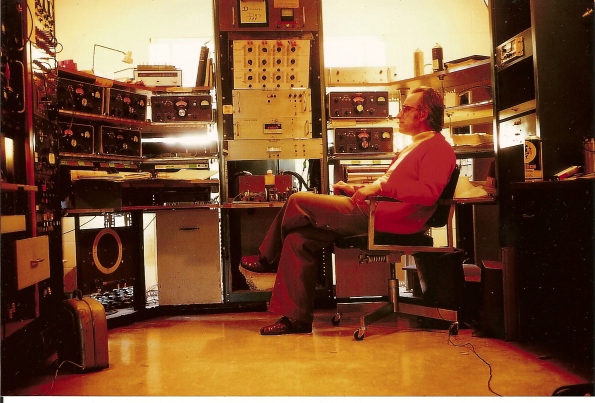
Jorma pioneered high resolution spectrograph observations of Jupiter’s decametric emissions and published dozens of important scientific papers.
He observed Jupiter from Finland, using his large cross-polarized log-periodic tracking interferometer. Jorma was a visiting professor of radio astronomy at the University of Florida from 1966-68 and again from 1980-81.
Those of us who were fortunate enough to work with Jorma at Florida will never forget his single-minded dedication to his study of Jupiter emissions. He truly was a one-man-army. We often drove together, the 50 or so miles, out to the University of Florida Radio Observatory to observe a predicted Jupiter storm. Jorma often carried a large sheet of paper with him on which were plotted the times of all his observations, displayed on the Io-CML plane. As we waited anxiously for the activity to start, Jorma would consult his records, often saying “be patient, just a few more minutes – then we shall hear S-bursts.” And he was right.
He was a master craftsman – building antennas, receivers, and radio spectrographs. As he analyzed his data on long rolls of 35 mm film, he would often excitedly call you into his office to show off the patterns of modulation lanes or the shape of an L-burst that had caught his eye.
Jorma passed away only a few weeks after the death of his wife Liisa. We extend our condolences to their three children Marja-Liisa, Saara, and Pauli.
In a recent letter Marja-Liisa mentioned that as a toddler she and her Mom were in a park in Helsinki one dark winter evening. Marja-Liisa told her Mom “It’s good that there are so many stars and Jupiters to light up the darkness.” I believe since the tenth of November there has been one more bright light in the heavens. Jorma we shall miss you.
I started this astronomy club 12 years ago, in a mysterious way! I already was a member of The Planetary Society and Astronomical Society of the Pacific, and I used to give lectures and exhibits in a few schools and sport clubs, one day a representative from Liceo Los Robles, an elementary, middle and high school, came to my house and hired me. I now teach classes in the Natural Sciences during the day and for a few nights a week in astronomy. Since I didn't have any experience, I imitated the programs at the Miami Space Transit Planetarium. I have been an avid ¨customer¨ there since I was 10 years old! I never missed a lecture from Jack Horkheimer.
A very great achievement was the grant we received from the Society for Amateur Radio Astronomers (SARA). Thanks to the idea given to me by Dr. Purohit, in India, I contacted Mr. and Mrs. Lord with the request because, although this is a private school, we don't have the funds to obtain such fine equipment as a Radio Jove radio telescope! The school happily contracted a communications company and we had our antenna installed!
The antenna we installed is a Dual Dipole East West orientation anti-Phase 10 foot height. We have been observing solar flares, a possible A type storm on Jupiter, as well as some interference.
Editor's note: For more details about the SARA grant program see the article below
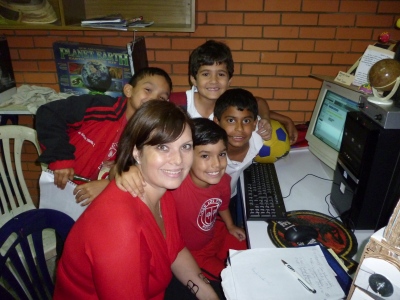
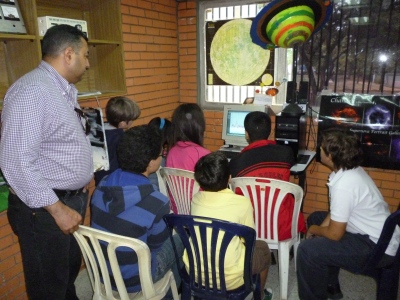
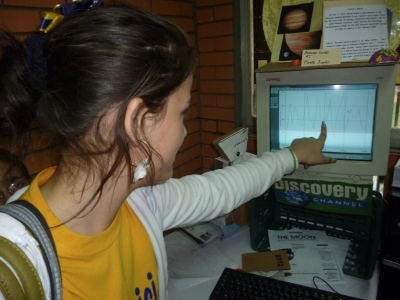
COAMND stands for Centre d'Observation Astronomique Des Monts Notre-Dame, which is a group of fourteen amateur astronomers. COAMND owns a private site with ten observatories equipped with various instrumentations ranging from a 3" refractor to a 36" Dobsonian. The site is located in the Appalachian mountains south of the St-Lawrence River at about 90 km southeast of Québec city. This site is quite remote from sources of light pollution and probably radio interference. While our members are primarily dedicated to visual astronomy and DSLR (Digital Single-Lens Reflex camera) or CCD astrophotography, over the past three years, some members have developed an interest in radio astronomy.
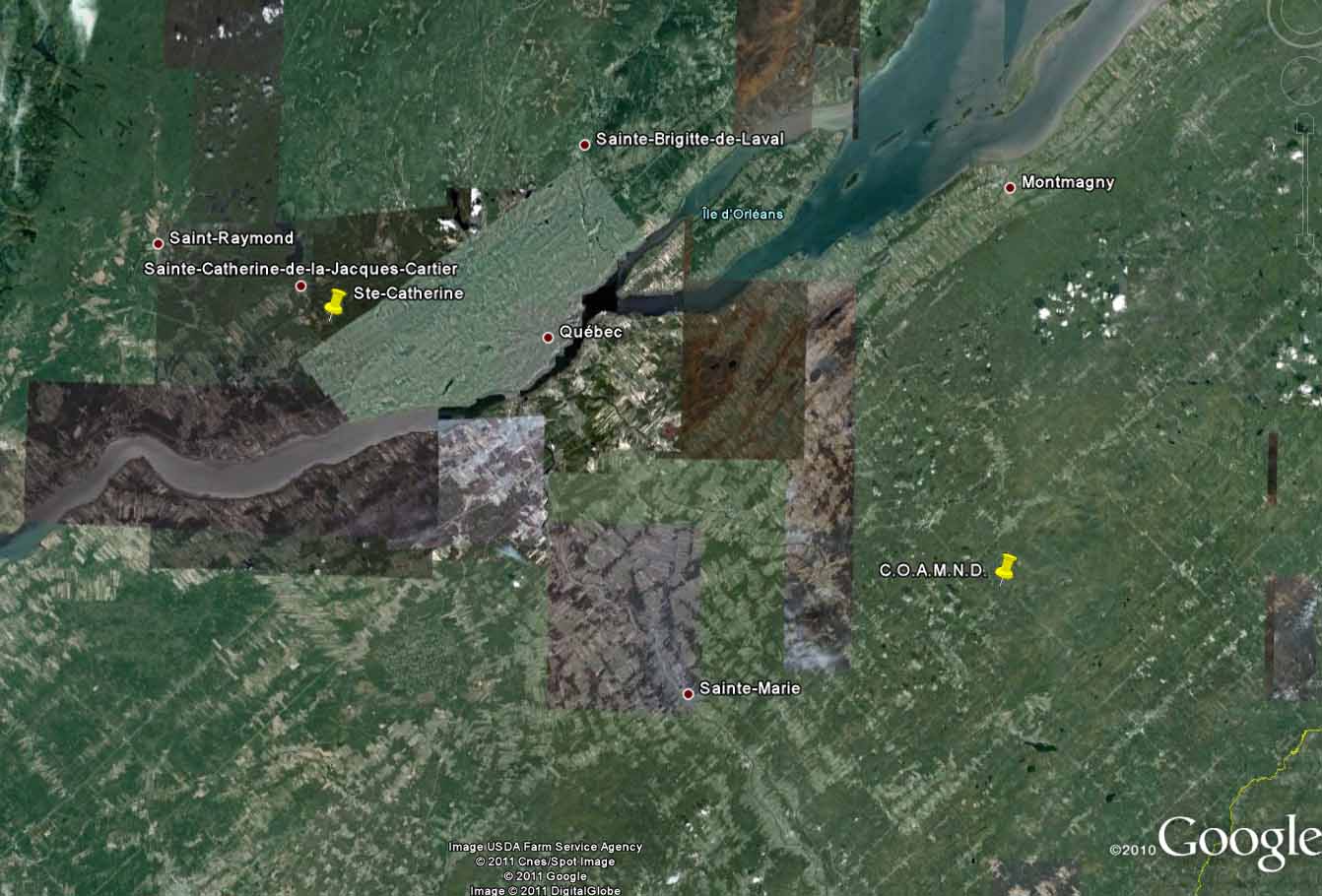
Presently, we operate one VLF station for monitoring Sudden Ionospheric Disturbances (SID) and two Radio JOVE antenna dual dipoles: one is located on the COMAND site and operated sporadically and the second is located at Ste-Catherine-de-la-Jacques-Cartier, 20 km west of Québec city in the backyard of a member.
The VLF station operates with two Gyrator circuit systems on a continuous basis. This signal is available via Radio-SkyPipe under the name of : COAMND 24kHz C.O.A.M.N.D. 24kHz NAA.
The RadioJove dual dipole located on the COAMND remote site is operated on a sporadic basis. A portable computer and the Radio JOVE receiver are powered via a solar panel and a battery pack which provided only two or three days of continuous operation. Therefore, we have to reset the system and return after a few days to get the data. Plans are being developed to improve this system.
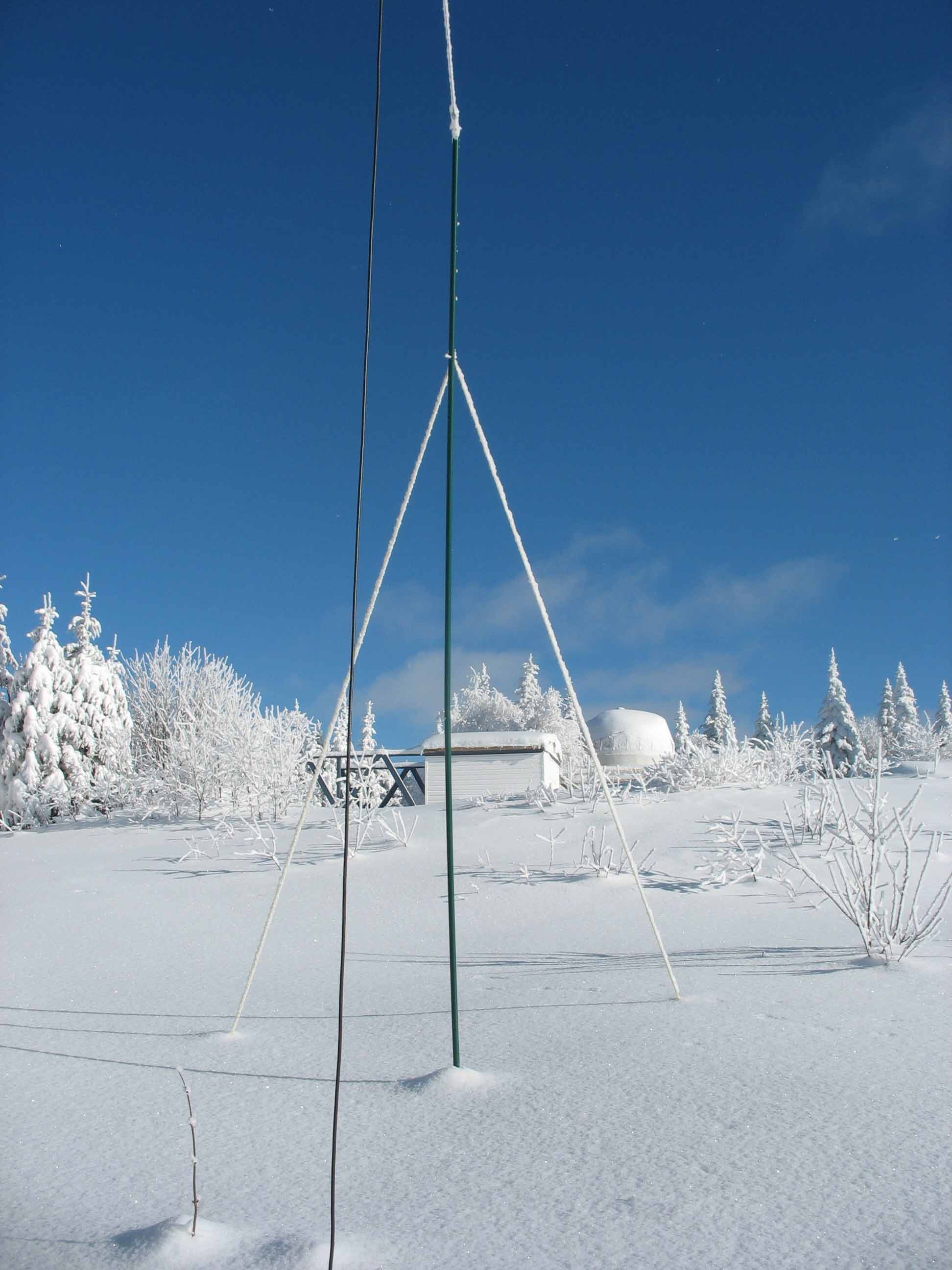
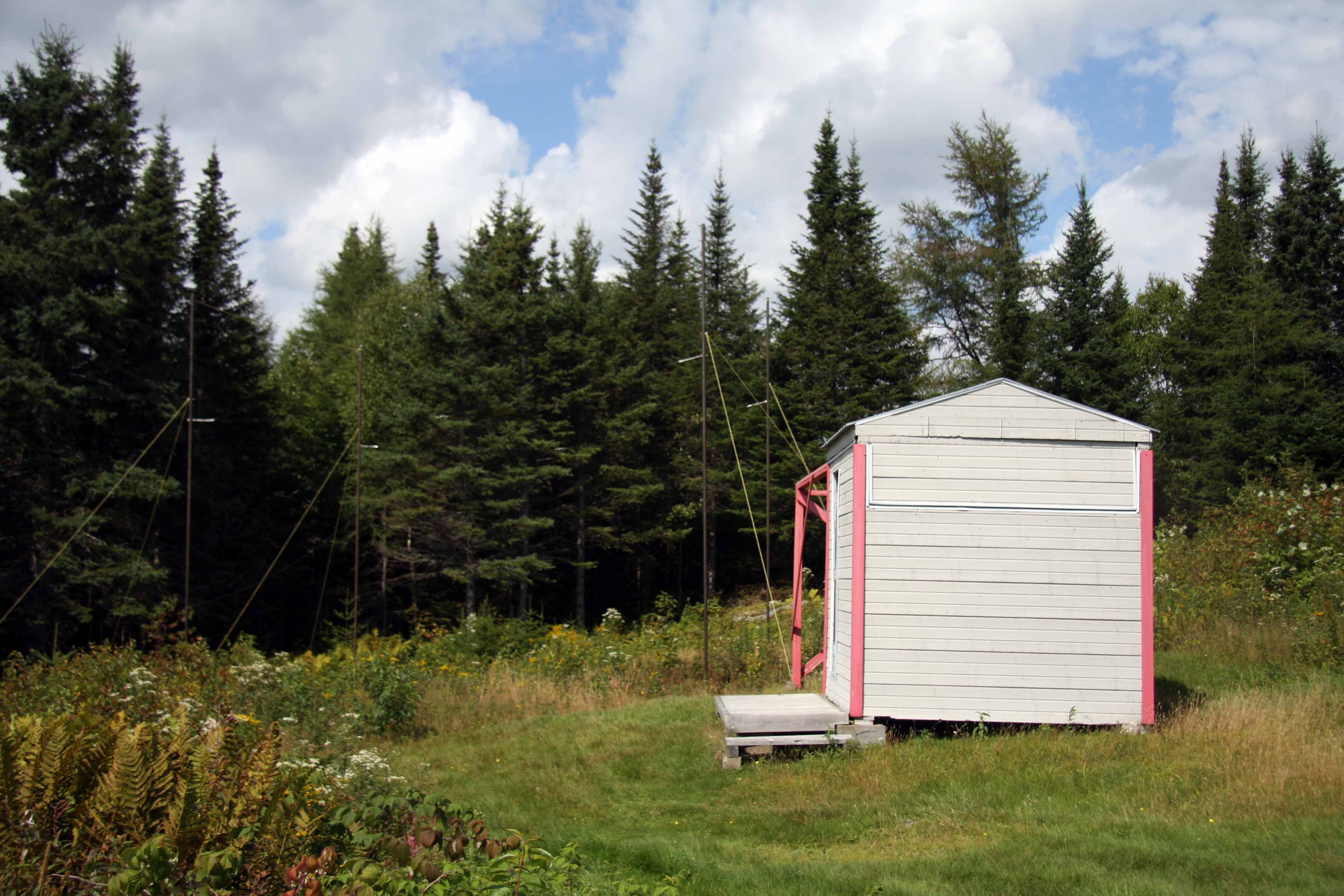
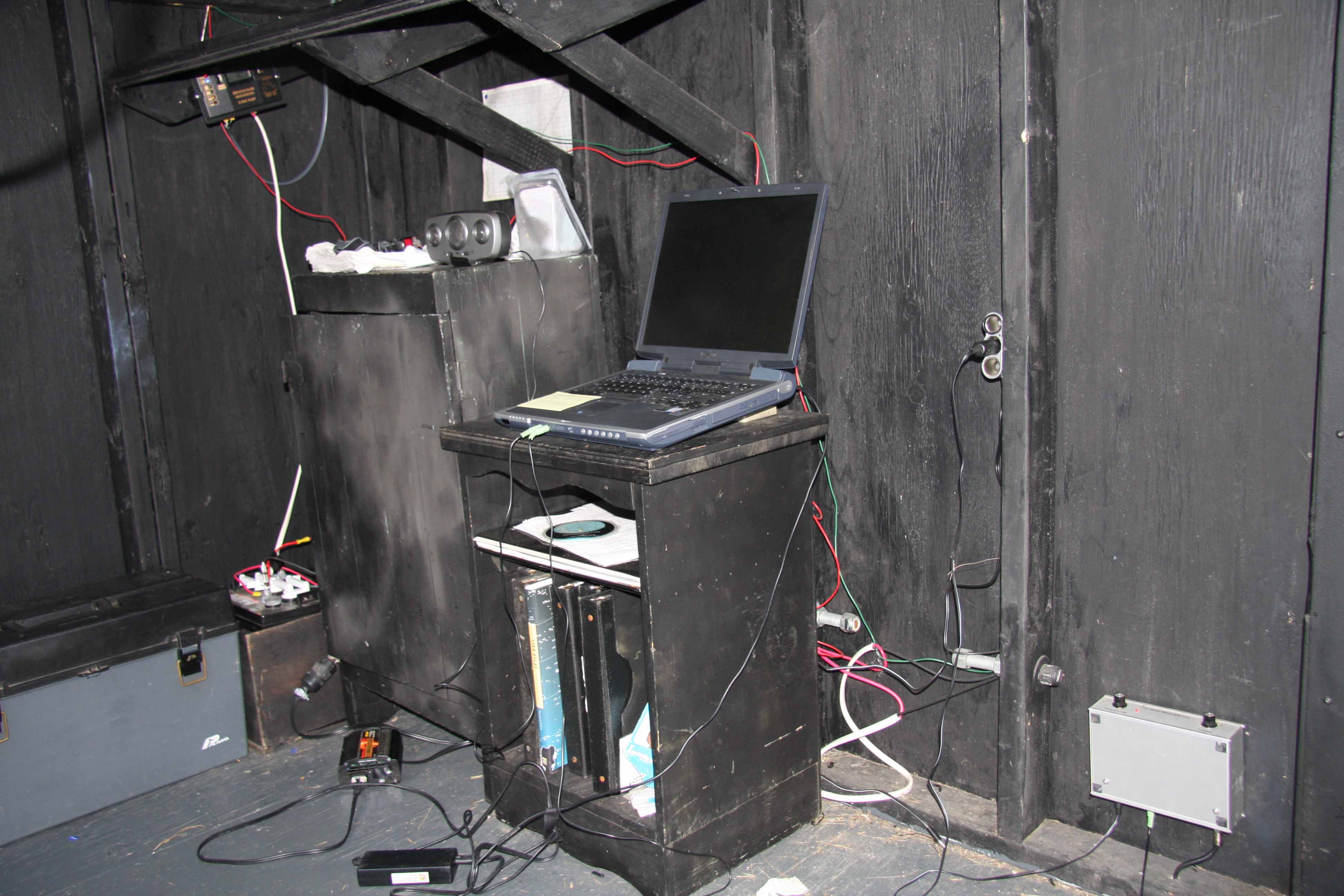
The RadioJove dual dipole antenna located at Ste-Catherine is operated on a continuous basis as it has access to electric power. A desktop computer operating Radio-Sky Pipe automatically saves at 00:00 UT the data on its hard drive. The signal is available via Radio Sky Pipe under the name : Dual dipole 21,1MHz C.O.A.M.N.D.
This computer can be operated remotely with the WinRemote PC software. When favorable Jupiter activity is foreseen sound recording is set up manually.
On a regular basis, all files are transferred to a private FTP site for backup and central data access. This central bank has had almost continuous recording, on a daily basis, since May 2010, except for power failure or maintenance of the system.
For more "deep radio sky" observing, a 3.3 meter dish has been installed on the Ste-Catherine site. This big dish has been used successfully to catch signals from the Moon and Cassiopeia A. It is operated at 3.7 GHz. Plans are being developed to use it to scan the sky and to improve its sensitivity.
The Society of Amateur Radio Astronomers (SARA) offers a student grant program for aspiring radio astronomers. Their president stated that “The Officers and Board of Directors feel strongly that we need to encourage young people in the study of science and radio astronomy and the grant program was established to help students fund their projects.” Funds have been set aside for students in grades 5 through college. An application is posted on the SARA web site http://www.radio-astronomy.org. Radio Jove equipment can be made available through this grant program to qualified applicants.
SARA membership income and sale of items from the SARA Store help to fund the student grant program. If you would like to join or find out more about SARA please visit our web site at the link mentioned above.
SARA is an international society of dedicated enthusiasts who teach, learn, trade technical information, and do their own observations of the radio sky. This organization is a scientific, non-profit group founded for the sole purpose of supporting amateur radio astronomy. SARA was organized in 1981, and today has hundreds of members worldwide. The group consists of optical astronomers, ham radio operators, engineers, teachers and non-technical persons. Many of our members are new to the field, and membership is extended to all who have an interest in radio astronomy.
The most recent and prized possession at my observatory is a Spectrograph, built by Dick Flagg. The spectrograph, allows you to see how radio signals are distributed across a broad swath of radio spectrum. The spectrograph is designed to be sensitive and fast enough to detect changes which occur in the radio emissions of the Sun and Jupiter. Fig. 1 is a solar burst; Fig. 2 is a series of Jupiter L-bursts. On the right is frequency in MHz and the bottom is time UT.
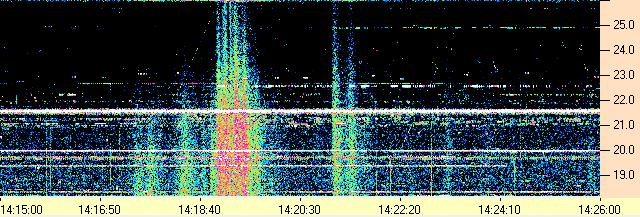
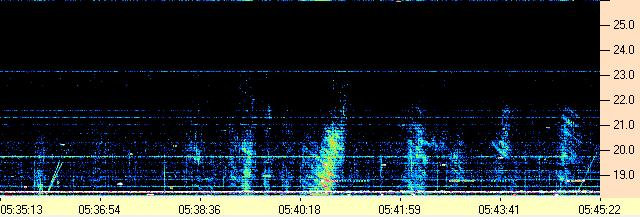
One evening in October, 2011, I was working at the computer during a rain storm when I heard the rain become a downpour. I happened to look over at the spectrograph display and saw this, Fig. 3.

I sent the image to Dick Flagg and asked him what he thought might have caused the display. His thought was that it was precipitation static.
When looking for information regarding precipitation static on the internet, you get back many results. Some of those are listed here:
The next image was captured during a particularly heavy downpour, on November 14, 2011. You can see where the rain started, came down hard, let up, and then came down hard again.
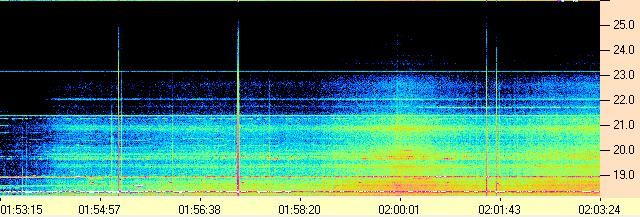
The corresponding Radio SkyPipe chart (Fig 5) showed that the precipitation static level rose to around 140K, or some 3.3 dB above the galactic background of 65K.
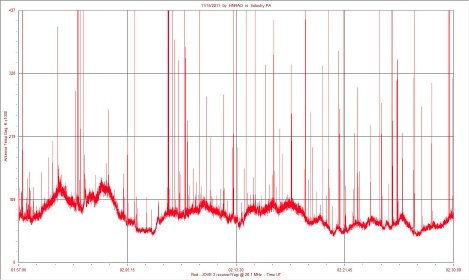
At no time did I see the effect rise above 23 MHz. Since my Spectrograph was only scanning from 18 MHz and up, I can’t say where the bottom of the effect occurs. But it’s clear that the intensity appears stronger in the lower frequencies from 19 MHz and down.
In looking on the internet, I read a paper that had been done in trying to quantify the electric charge of rain drops. Other researchers were more interested in the effect it has on aircraft. Others, such as NASA study this effect as it applies to both aircraft and, spacecraft during launches.
Who knew you could see precipitation static with a back yard dipole antenna? That’s one of the things I love about radio astronomy. There is always something new to discover and learn and it doesn’t always necessarily have to do with astronomy. So if you see something on your chart you can’t explain, ask someone. It might be nothing; then again, it might be something important. We learn when we ask, “why?”
We had a very good Jupiter Io-B pass on the evening of January 2, 2012 UTC and it continued into January 3, 2012 UTC. The storm began here just before the sun set and since Jupiter was not in the beam of the antenna until an hour after the pass started, I wasn't expecting much at the start. I was surprised. Activity was also observed by Thomas Ashcraft in New Mexico and Wes Greenman in Florida. Interestingly, in this pass, I was receiving Jupiter emission on my spectrograph in Pennsylvania that Wes Greenman was not receiving on an identical spectrograph in Florida. And on the Io-A pass that preceded this one a few days earlier, Wes was receiving Jupiter emission when I was not. I have learned that when dealing with Jupiter, expect the unexpected.
First indications here started at about 2230 UT 1/2/2012 and continued through 0030 UT 1/3/2012. There were S bursts at the beginning of the storm, followed by L bursts. Modulation and Faraday lanes were present. Most of the activity was between 18 MHz and 21 MHz but ran up to around 25 MHz. There was a lot of activity at 20.1 MHz (JOVE) so if you were running your chart, you'll want to make sure you check your data. On the spectrograph image below, L bursts are seen as long structures, some nearly vertical, but most at an angle.
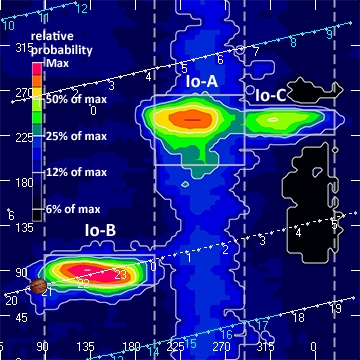


A New Phase Plane
As you may have noticed in the Radio Jove mailing lists, there is a new Io-CML(III) phase plane image afoot. This new phase plane is available in the latest release of Radio Jupiter Pro.
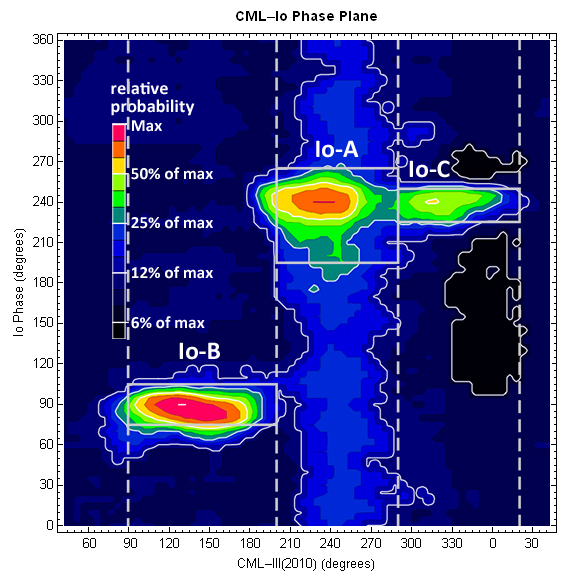
This Io-CML phase plane image attempts to depict the relative probability of receiving Jovian emissions near 20 MHz. This was accomplished by first making an average of probability data, in 5° by 5° bins, generated from observations made at 18, 20 and 22 MHz at the University of Florida Radio Observatory (UFRO) from 1957 to 1994. The resulting averages were then scaled (normalized) so that the peak probability in the Io-B source region lies at 100% relative probability. Drs. Chuck Higgins, Francisco Reyes, and James Thieman made their hard-won and reduced UFRO data available; I then generated the phase plane graphic image using an interpolated contour plot in the math software package Mathematica. The plot is designed so that the borders between successive colors represent 1 dB steps downward from maximum relative probability.
Note the use of the term "relative probability". The new phase plane shows probabilities of observation relative to the maximum in the Io-B region. This maximum is located at roughly CML(III) = 130° and Io Phase = 90° from Superior Geocentric Conjunction (SGC), represented by the small horizontal white line in the Io-B region in the phase plane shown above.
In contrast, the absolute probability of observing Jovian emission at any given time is almost impossible to predict because it is affected by so many variables. Some of these are the observing frequency, transparency of the earth's ionosphere, duration of the observing session, antenna gain, receiver sensitivity, galactic background noise level, man-made noise level, position of Jupiter relative to the Sun, and the jovicentric declination of Earth, De (see Jove Bulletin May 2011).
The new phase plane image is a useful guide for the Jove observer; however, it cannot be used to predict events with absolute certainty.
Note: See the book Listening to Jupiter by Richard Flagg — available on the Jove CD — for explanations of the terms CML(III) and Io SGC. A brief explanation of these terms may also be found online at the University of Florida Radio Observatory and in the Radio Jove Science Brief, The Jovian Decametric Radio Emission
More Radio Jupiter Pro Enhancements
In addition to the new phase plane, Jim Sky has added several more features to the latest release of Radio Jupiter Pro (RJP), version 3.5.7. They include:
The Radio Jupiter Pro software may be downloaded from the Radio Sky site here: http://radiosky.com/rjpro3ishere.html
Mexico City, Mexico
Alfonso Castillo Abrego reports that "Our Radio Jove antenna caught the attention of participants at the 'Stars in the Night' event at the National Autonomous University of Mexico (UNAM)."
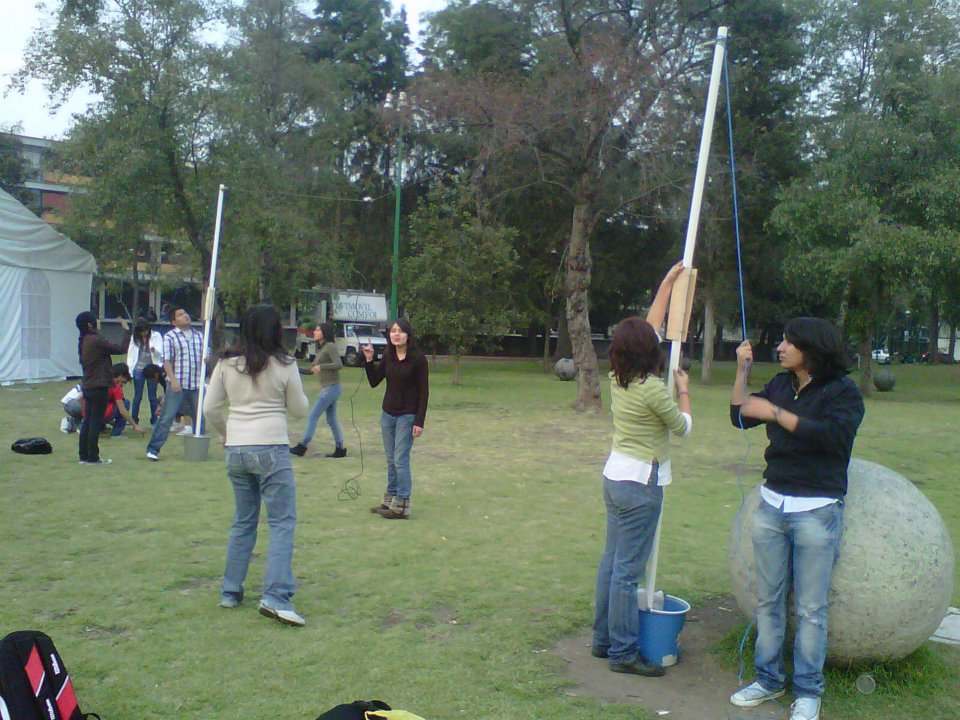
Delhi, India
Prafull Sharma reports that "The Amateur Radio Club of Ahlcon Public School, Delhi, India received a grant from the Society of Amateur Radio Astronomers (SARA) for a Radio Jove system. The club members Prafull Sharma, Ayush Raina, Arjun Nair and Hardik Kumar, students of Ahlcon Public School are guided by Mr. Tushar Sharma, an Engineering student, Maharaja Surajmal Institute of Technology (MSIT). On receiving the grant, the members of the radio club were excited about knowing the mysteries that were wrapped inside. It took approximately 4 weeks to make the Radio Jove System, the receiver and the dipole antenna. Our mentor, Tushar explained each aspect of the equipment. The group attempted to observe the Leonid Meteor Shower using the Radio Jove and received a few signals. There was a bright lit moon limiting our eyes to view the spectacular event, but still the radio observations were taken successfully."
For more details about the SARA grant program see the article above
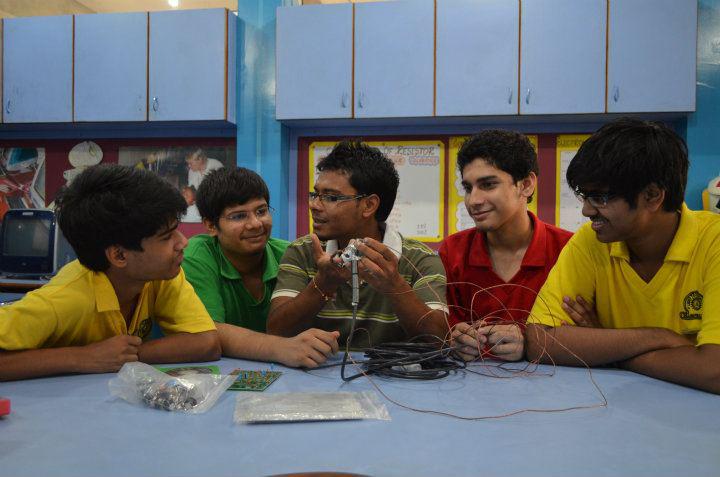
Washington D.C., United States
Francisco Reyes reports that "Dr. Ata Sarajedini, Professor and Associate Chair of the University of Florida Astronomy Department led the UF group that participated in the USA Science and Engineering Expo in Washington on April 28-29. The UF theme for this year was 'Gators in Space'. He kindly carried about 60-70 Radio Jove brochures and he distributed all of them during the expo."
The JOVE Bulletin is published twice a year. It is a free service of the Radio JOVE Project. We hope you will find it of value. Back issues are available on the Radio JOVE Project Web site, http://radiojove.gsfc.nasa.gov/
For assistance or information send inquiries to:
or
